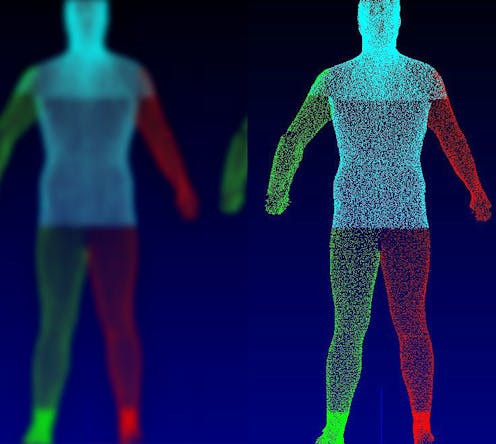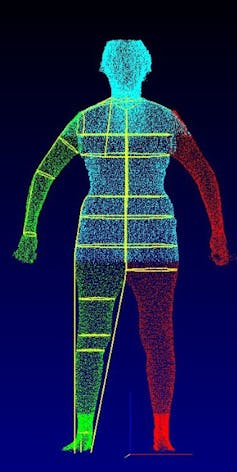What you see in a 3D scan of yourself could be upsetting
When people see their bodies in 3D, they feel worse about themselves and more negative in general. That might not put shoppers in a buying mood even for clothes that fit better.

Amazon is reportedly looking for people who are willing to have their bodies scanned in 3D in order to track and measure subtle changes in their sizes and shapes. It’s part of the company’s broader push to sell more clothes by more accurately predicting how garments will fit different body shapes.
But Amazon may not be considering the psychological effects 3D body scans can have on consumers. In April 2018, I published a study that found when a person views their body in 3D, it makes them feel sadder and worse about their appearance. Increasingly sophisticated 3D scanning technologies might seem to offer retailers a competitive edge, but a customer who has just been scanned may feel bad about how they look and not be up for buying anything at all.

Getting a 3D view
Previous research I conducted on body shape perception found that people believed that a 3D body scan was an accurate depiction of their real body. That belief inspired me to further explore people’s feelings about seeing their bodies in 3D. Seeing your body in 3D is, at the moment, rare and unusual: Even mirrors and photos show only two-dimensional views. If retail stores are going to let more people see their own bodies in 3D, I reasoned, there may be wider effects on society.
To understand what happens when someone sees him or herself in 3D, I conducted a study of students at Florida State University, where I work. A total of 101 men and women came to my body scanning research laboratory, where they participated in a survey, were body scanned and then took the same survey again.
The survey contained questions to measure body satisfaction, mood and appearance management behaviors. For example, people were asked how they were currently feeling about their overall appearance and body shape and size; the degree to which they were at that moment feeling happy, sad, grouchy and other emotions; and how likely they were to engage in certain activities, like dieting and exercise.
Additionally, both before and after the scan, I gave participants a group of line drawings of bodies and asked them to select the figure that most closely represents their actual self. They then viewed the collection of figures again and were asked to select the figure which most closely represents the ideal way they would like to look.
Changing feelings about their bodies
The difference between their indication of actual and ideal served as a measure of how differently each of them perceived who they actually were from who they wanted to be. People who chose very different real and ideal body shapes are more likely to feel sad and depressed.
I compared participants’ self-perceptions before and after they viewed their 3D body scans. After seeing their body scan, the participants – both men and women – perceived their actual selves to be almost one figure larger than what their perception had been before seeing the scan. For men and women, their ideal stayed about the same, or was in fact slightly smaller than their original choice.
As a result of this changed perception, participants reported feeling less satisfied with their bodies and more negative in general. These bad feelings were strong enough to increase their stated willingness to change their behaviors, including saying they were more likely to diet and exercise. Future studies could determine whether people actually followed through on those feelings.
A caution for retailers
If Amazon and other retailers plan to use body scanning as part of their customers’ experience, they should know how and why people respond negatively – both about themselves and in general – to seeing a 3D scan of their bodies. Those responses, like all emotional changes, are likely to affect their shopping behaviors.
Retailers might be able to use 3D scans to provide better-fitting clothes to their customers, but buyers might choose to go home and diet and exercise first. Days, weeks or months later when they return to shop, ideally in a better mood and feeling better about their bodies, will they go to a place that showed them everything that was wrong? Or will they seek out a more affirming environment? These questions and others like them will be examined in my future research. But for now, it’s hard to say whether 3D body scanning will boost forward-thinking retailers, or if it will create a new group of dissatisfied consumers.
Jessica Ridgway Clayton ne travaille pas, ne conseille pas, ne possède pas de parts, ne reçoit pas de fonds d'une organisation qui pourrait tirer profit de cet article, et n'a déclaré aucune autre affiliation que son poste universitaire.
Read These Next
How are dark matter and antimatter different?
Normal matter – which makes up everything we see and touch – isn’t the only type of matter present…
Writing builds resilience by changing your brain, helping you face everyday challenges
Resilience is often presented as feats of bravery and endurance. But everyday practices like journaling,…
Who wins and who loses as the US retires the penny
Ending production of the 1-cent coin will save the government money and could streamline big retailers’…




